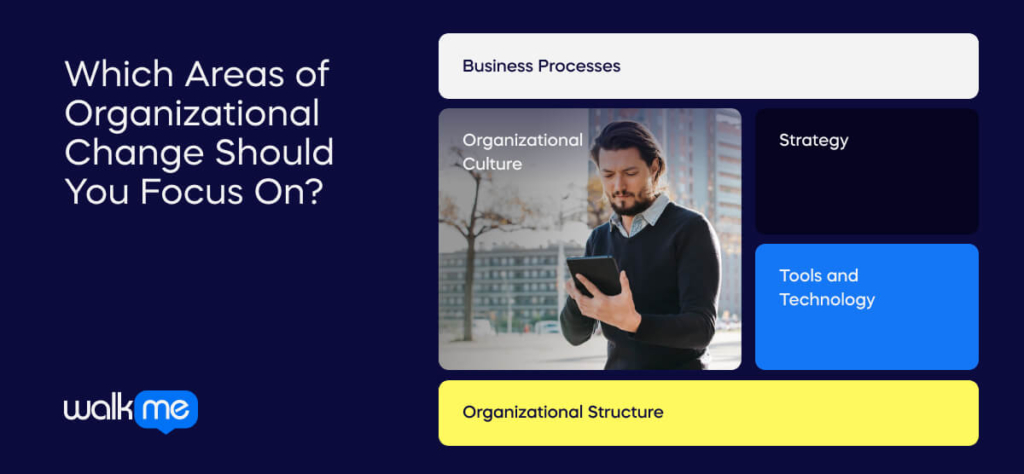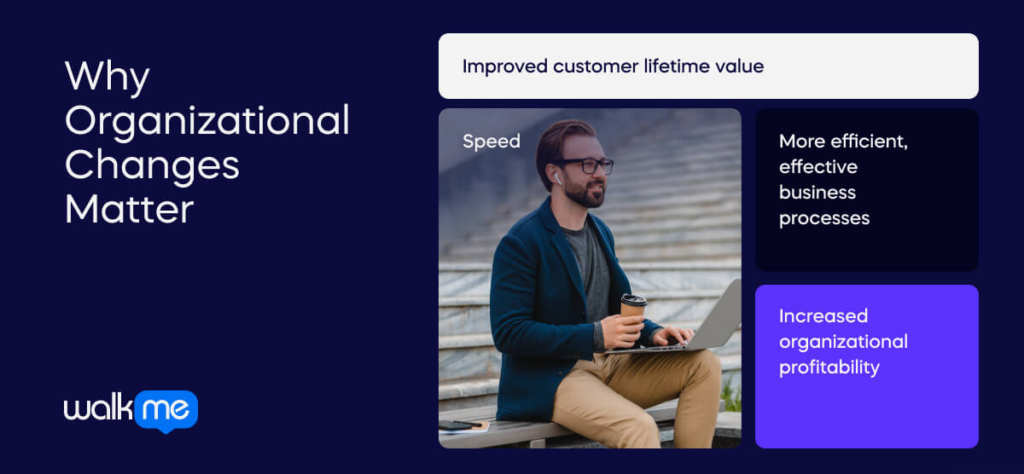What are the most important areas of organizational change?
That is – where should you focus your change management efforts?
Below, we will look at:
- Which areas of an organization can – and should – be changed
- When they should be changed
- Why organizational change matters
- Some barriers to organizational change
And more.
To start, let’s find out what business areas should be the focus of organizational change.
Which Areas of Organizational Change Should You Focus On?

In business, there are countless things that can be changed:
- Procedures
- Rules
- Organizational Structure
- Strategy
To name just a few.
But which ones are most important?
And when does the cost outweigh the benefits?
To find out, let’s look at a few areas of organizational change in more detail.
Business Processes
Processes, systems, and procedures are one of the “easier” areas to change.
This type of change often involves:
- Establishing a new process or procedure
- Communicating and explaining the new process to employees
- Offering training when necessary
- Putting the procedure into practice
- Reinforcing that new process
In some cases, these changes can be relatively simple.
If the change involves more complex processes, though, the change could become much more involved and complex.
Organizational Culture
Organizational culture affects business changes so it is sometimes a good idea to shift that culture.
However, note that culture is often more difficult to change than, for instance, business processes.
However, cultural change programs pose certain challenges:
- Changing culture involves influencing and changing what people believe, their values, their philosophy, and so forth. This could easily result in resistance or negative reactions from employees
- The culture of an organization is usually already well-established. Intentionally changing that culture could require change campaigns that are both extensive and expensive.
- How do the benefits and costs compare? When a corporate culture would obstruct a certain change project, then such a change program would be warranted. However, the costs should be carefully assessed beforehand.
In short, cultural changes involves changing the hearts and minds of employees.
Such changes can certainly be profitable – and in some cases necessary. However, bear in mind that these changes may take longer and cost more than other change projects.
Strategy
Changes to organizational strategy also occur from time to time.
An organization may decide to:
- Focus on a new marketplace
- Change its target audience
- Alter specific strategies, such as marketing strategies or customer experience strategies
Strategy can be thought of as the “guiding compass” for an organization. It is the way an organization chooses to achieve its objectives.
Therefore, strategic changes will often result in other organizational changes.
Those can include everything from process changes to the introduction of new technology or departments.
Tools and Technology
Today, one of the most common areas of organizational change revolves around technology.
Such changes often fall under the umbrella of digital transformation.
Digital adoption, for instance, is common in today’s digitizing workplace.
This process involves steps that include:
- Adopting and implementing new technology
- Onboarding and training employees on that technology
- Analyzing software usage and taking steps to maximize productivity and software ROI
The adoption of new technology, of course, may have many other impacts in the workplace.
Many other changes may follow introducing a new tool or technology, such as new workflows, processes, restructuring, and so on.
Organizational Structure
Another well-known organizational change is restructuring.
This can take forms such as:
- Recruiting new personnel
- Downsizing
- Changing job roles, responsibilities, titles, or functions
The restructuring of an organization usually has a specific aim or cause.
Budget cuts or tough economic conditions, for example, may cause a company to downsize.
Or a strategic change may involve the creation of a new department.
Why Organizational Changes Matter

The examples listed above are not exhaustive.
But they should give a good idea about which areas an organization may choose to change.
However, what benefits can be gained from making such changes?
After all, as the old adage goes, “If it ain’t broke, don’t fix it.”
Though that may be true, organizational changes can provide significant benefits to an organization, such as:
- Improved customer lifetime value. For instance, improving the sales process or the customer experience can increase a customer’s average lifetime spend.
- More efficient, effective business processes. Better business processes are often less wasteful and more cost-efficient – resulting in a lower overhead for the business.
- Speed. In many cases, faster is usually better. For instance, more efficient software development workflows can decrease the time-to-market for new software versions.
- Increased organizational profitability. Ultimately, successful organizational changes improve organizational results. This can improve both top- and bottom-line margins, helping an organization to be more successful and more profitable.
Change management is a deep, sophisticated discipline.
The right changes can deliver massive gains and offer significant returns.
However, change is not always easy – in fact, it is usually challenging.
For this reason, effective change management is an absolute must when any business decides to make an organizational change to an area of business.

